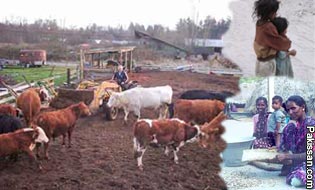|
Livestock reduces poverty
By Murtaz-ul-Hasan & M. Abbas Aziz
THE share of crops in value-addition in agriculture has
gradually declined from 65.1 per cent in 1990-91 to 47.5 per
cent in 2005-06, while the share of livestock has increased
from 29.8 to 49.6 per cent. Livestock contributes almost 10
per cent of overall export earnings.
 The
livestock sector posted a steady growth of around five per
cent in the last decade. However, the growth slowed down to
2.6 per cent in 2003-04 and 2.3 per cent in 2004-05 but it
shot up to eight per cent during 2005-06. The
livestock sector posted a steady growth of around five per
cent in the last decade. However, the growth slowed down to
2.6 per cent in 2003-04 and 2.3 per cent in 2004-05 but it
shot up to eight per cent during 2005-06.
Within this sector, milk is the largest and the single most
important commodity. Despite decades of neglect, Pakistan is
the 5th largest milk producer in the world. The total value
of milk produced is higher than the value of two major
crops, that is, wheat and cotton.
With 35 million people engaged, the role of livestock in
rural economy is critical. On an average each family holds
about 2-3 cattle/buffalo and 3-4 sheep/goats and derives 30
to 40 per cent of its income from it. The most effective
means of alleviating poverty is introducing measures that
target the poor directly. The livestock sector has close
links with poverty reduction.
Livestock production is one important enterprise in which
small scale rural producers can successfully engage to
improve their livelihood and obtain a relatively constant
stream of income thus moving from subsistence to market
orientation. However, low productivity has added to income
inequalities of livestock farmers. The majority of poor
households, especially landless or small landowners, depend
on livestock for income.
The role of women as providers of labour is important.
Pakistani rural woman spends between one-fifth and
one-quarter of her working hours in livestock related
activities; the grazing and watering of animals, the sale of
products to agents, and the care of sick animals. In
cleaning animals and caring for sick ones, the work of both
sexes is approximately the same. Women are exclusively
responsible for cleaning sheds, manure collection, egg
collection and selling produce to villagers.
An effective way of increasing the protein intake of poor is
by enhancing livestock production. Another approach is to
create higher demand for labour and services provided by the
poor. The spill-over effects from such growth is limited
because large-scale livestock production tends to be capital
and energy intensive as opposed to labour-intensive. Growth
in large-scale commercial sector is unlikely to generate
additional employment opportunities for the rural poor.
A preferred approach is to make best use of labour-intensive
innovations that make use of surplus family labour and, to a
lesser extent, create some local employment opportunities
for non-family members. In rural areas farming, livestock,
and non-farm activities are major sources of employment and
income. The incidence of poverty is higher for those who
depend solely on livestock and lower for those who have both
crop farming and livestock activities. The majority of
non-poor depends on crops while the poor on livestock.
Although, the economics of livestock production is heavily
distorted in favour of large-scale producers, yet this
sector has enormous potential to combat poverty and
strengthen economic growth. Its projected growth in
livestock offers a unique opportunity; a rapidly growing
market of which many rural people already have the
experience and which they can enter without the need for
substantial resources and training. Enhancing production
doesnít offer a universal solution to rural poverty but for
many it represents a practical way to build assets and
financial security. Livestock development is imperative for
strengthening of the national economy as it has full
potential for job creation, meeting food requirements and
taking a very active part in export drive in globalization.
Pakistanís share in world milk production (five per cent) is
double its share in global population. The increase in
production recorded so far is largely due to rise in number
of animals rather than an increase in per dairy animal
yield.
International comparison shows that the productivity (annual
yield per dairy animal) of New Zealand dairy animals is
three times the Pakistan average. This difference is due to
a variety of reasons that include better genetics and
technology, animal health services, proper nutrition and
etc.
Unabated increase in animal population may not be a
solution. The appropriate way to go forward is through
increases in yield and not number through better genetic
technology, animal healthcare and more nourishing feed for
livestock. This strategy can help the low-income groups in
procuring sustainable livelihoods in rural and peri-urban
areas.
Another area which needs attention is to improve and extend
veterinary services to village level. Production of green
fodder should be increased by growing high yielding
varieties and following improved agronomic practices. The
animal herders at village level should be educated to use
urea and molasses with roughages for improved nutritive
value.
The depleted range lands in desert, arid and semi-arid
regions should be improved by adopting well-established
technology for each region. Scattered livestock herders
should be organized on community basis. Arrangements should
be made to collect and take milk to the nearest centre for
chilling before transporting the same to a processing plant.
The village organizations should be provided advisory
services and training for better management of their animals
by improving their breeds, feed, and health. Necessary
veterinary services should be provided at grassroots level,
besides improving their marketing system.
Since the livelihood profiles and productivity patterns of
the large, landless community of livestock owners and the
other community of landed livestock owners are different, it
is desirable to follow of nuanced and different strategies
for the two communities.
Courtesy:
The DAWN |
Pakissan.com;
|